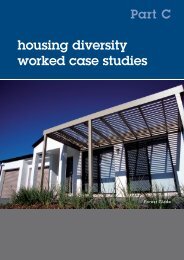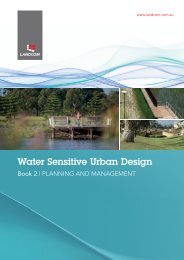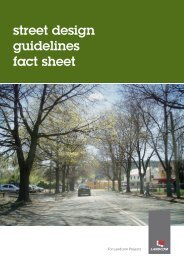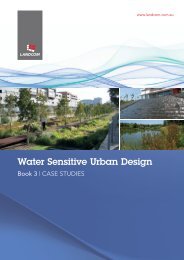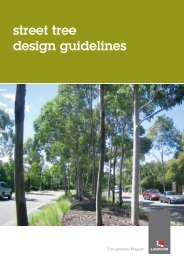to download the PDF - Landcom - NSW Government
to download the PDF - Landcom - NSW Government
to download the PDF - Landcom - NSW Government
You also want an ePaper? Increase the reach of your titles
YUMPU automatically turns print PDFs into web optimized ePapers that Google loves.
casestudy<br />
Environmental sustainability<br />
Exceeding our sustainability<br />
benchmarks at Bunya<br />
At Bunya, we are committed <strong>to</strong> modelling<br />
sustainability initiatives that will exceed<br />
current <strong>Landcom</strong> practice and <strong>the</strong> stretch<br />
sustainability targets we have set for <strong>the</strong><br />
Corporation as a whole. There are some<br />
notable highlights, including our plans <strong>to</strong>:<br />
Our environmental impact is assessed by moni<strong>to</strong>ring and measuring <strong>the</strong> way we manage<br />
our water and energy use, our greenhouse gas emissions, our waste, native vegetation and<br />
riparian corridors, and our design influence.<br />
Urban water cycle management<br />
••<br />
deliver a reduction in energy use <strong>to</strong><br />
achieve a BASIX score of 65% for<br />
dwellings at Bunya (our current target is<br />
50% and <strong>the</strong> regulated compliance target<br />
is 40%)<br />
••<br />
introduce a wide range of measures that<br />
reduce water consumption on this project<br />
so that dwellings achieve a 50% BASIX<br />
score, exceeding our current target of<br />
45% and <strong>the</strong> compliance target of 40%<br />
••<br />
double our current target of sourcing up<br />
<strong>to</strong> 5% of all electricity used onsite from<br />
renewable sources.<br />
Our measures will ultimately save residents<br />
around $600 per year in electricity bills and<br />
$300 in water bills, based on current costs.<br />
When complete, Bunya will deliver annual<br />
greenhouse gas savings of almost 5,500<br />
<strong>to</strong>nnes (<strong>the</strong> equivalent of almost 2,000 return<br />
flights from Sydney <strong>to</strong> Los Angeles) and an<br />
annual reduction in overall water use of 114<br />
megalitres (enough <strong>to</strong> fill over 45 olympic<br />
sized swimming pools)*.<br />
These ambitious targets are testing <strong>the</strong><br />
ingenuity of our project team and builder<br />
partners, who are working closely with us <strong>to</strong><br />
ensure that we deliver <strong>the</strong>se results without<br />
significantly increasing overall project costs.<br />
The thinking behind our indica<strong>to</strong>rs<br />
Quality<br />
There are many ways we could moni<strong>to</strong>r <strong>the</strong> impact of our<br />
developments on <strong>the</strong> urban water system, but one of <strong>the</strong> more<br />
accurate proxies for <strong>the</strong> overall health of <strong>the</strong> water system is <strong>to</strong><br />
measure <strong>the</strong> mean annual load of nitrogen, phosphorous and<br />
suspended solids.<br />
Our targets are:<br />
••<br />
45% reduction in nitrogen – with a stretch target of 65%<br />
••<br />
65% reduction in phosphorus – with a stretch target of 85%<br />
••<br />
85% reduction in suspended solids – with a stretch target of<br />
90%.<br />
Management<br />
Good planning is vital <strong>to</strong> reducing water pollution. We report<br />
on <strong>the</strong> percentage of projects that have water sensitive urban<br />
design (WSUD) strategies in place at <strong>the</strong> planning and design<br />
phase. This ensures that conserving water and improving its<br />
quality are firmly embedded in our development processes.<br />
Our aim is <strong>to</strong> go beyond <strong>the</strong> minimum BASIX requirements.<br />
For homes we build in partnership with builders and<br />
developers, we split targets in<strong>to</strong> four categories, based<br />
on whe<strong>the</strong>r <strong>the</strong> homes are apartments or single/attached<br />
dwellings, and whe<strong>the</strong>r <strong>the</strong>y are serviced by a recycled water<br />
scheme.<br />
Our targets are:<br />
••<br />
45% reduction for single and attached dwellings not<br />
serviced by reticulated recycled water – with a stretch target<br />
of 60%<br />
••<br />
45% for all apartments not serviced by reticulated recycled<br />
water – with a stretch target of 55%<br />
••<br />
60% for single and attached dwellings serviced by<br />
reticulated recycled water – with a stretch target of 70%<br />
••<br />
55% for all apartments serviced by reticulated recycled<br />
water – with a stretch target of 65%.<br />
Protection<br />
We’re acutely aware of <strong>the</strong> need <strong>to</strong> minimise any adverse<br />
impacts on natural waterways caused by surface runoff from our<br />
developments.<br />
We assess our impact by modelling pre and post-development<br />
s<strong>to</strong>rmwater discharges and, through our Stream Erosion Index,<br />
<strong>the</strong> impact of our developments on receiving waterways. Our<br />
flow management target, which includes <strong>the</strong> Stream Erosion<br />
Index, is applied <strong>to</strong> greenfield sites and wherever <strong>the</strong>re is a<br />
natural stream downstream of a development.<br />
The target aims <strong>to</strong> bring <strong>the</strong> volume and duration of<br />
s<strong>to</strong>rmwater flows from a developed catchment <strong>to</strong> less than two<br />
times that of a natural catchment of <strong>the</strong> same size and location.<br />
Our stretch target is <strong>to</strong> match <strong>the</strong> volume and duration of<br />
s<strong>to</strong>rmwater flows from a developed catchment <strong>to</strong> those of a<br />
natural catchment.<br />
34<br />
*Compared <strong>to</strong> average 2005 consumption<br />
landcom annual report 2011<br />
BUNYA<br />
Conservation<br />
The amount of water we are able <strong>to</strong> conserve is influenced by<br />
fac<strong>to</strong>rs such as climate change, drought and <strong>the</strong> location of<br />
new infrastructure. But where we can make our influence felt is<br />
in minimising <strong>the</strong> consumption of potable water and capturing<br />
and recycling as much water as possible. To a degree,<br />
government legislation ensures that this happens. Any new or<br />
renovated home has <strong>to</strong> comply with <strong>the</strong> state government’s<br />
Building Sustainability Index (BASIX). BASIX’s aim is <strong>to</strong> limit<br />
potable water consumption and greenhouse gas emissions<br />
by imposing targets for water and energy reduction. Once<br />
<strong>the</strong> targets are met, a certificate is given <strong>to</strong> <strong>the</strong> owner and<br />
construction on <strong>the</strong> house or unit can begin.



